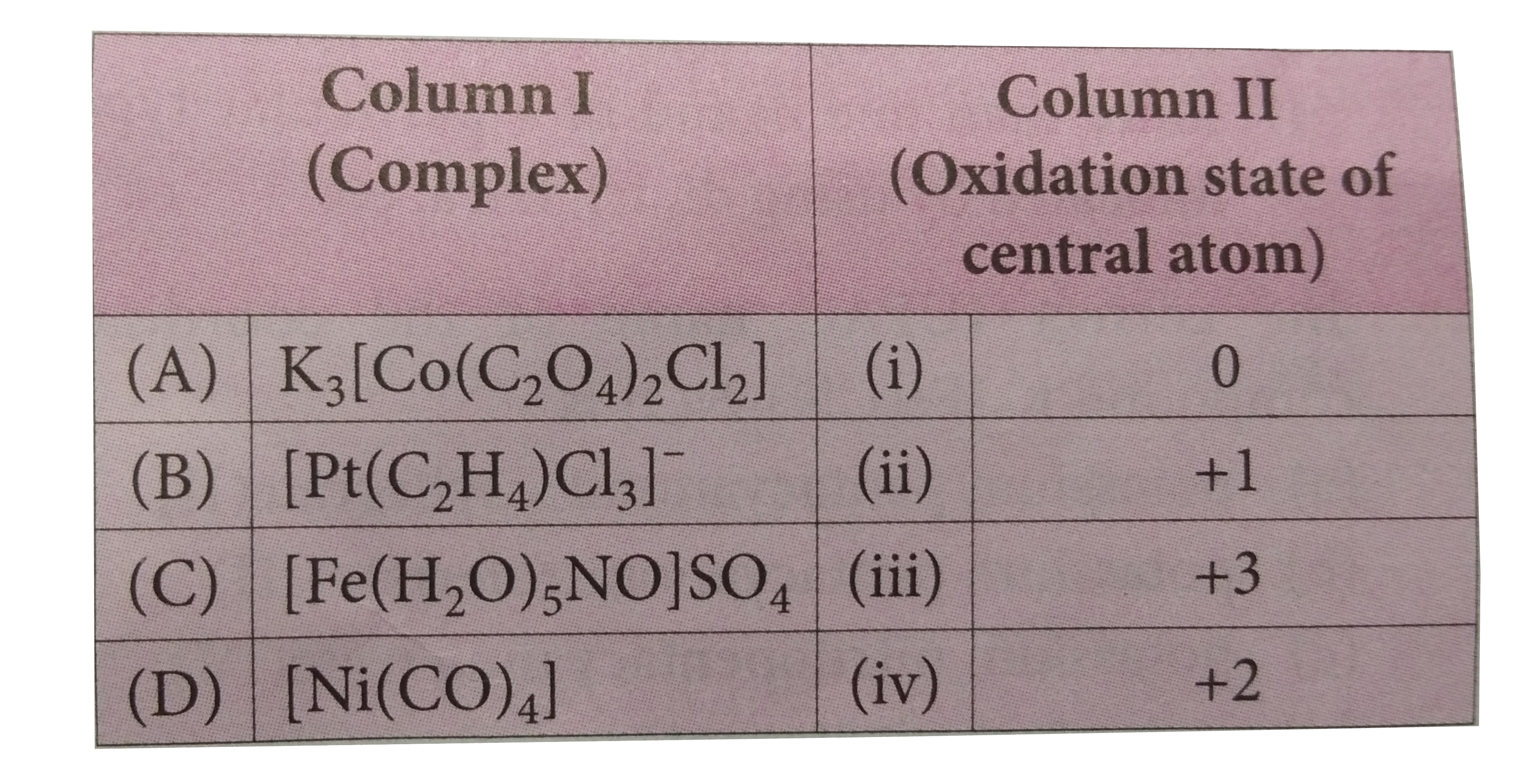Match the geometry (given in column A) with the complexes (given in column B) in :
Geometry : AComplex : BI Octahedral(P)[Ni(CN)4]2−II Square planar(Q)Ni(CO)4III Tetrahedral(R)[Fe(CN)6]4−
I - P, II - Q, III - R
I - R, II - P, III - Q
I - R, II - Q, III - P
I - Q, II - P, III - R
The correct Answer is:B
To solve the problem of matching the geometry of complexes with their respective complexes, we will analyze each complex and determine its geometry based on the hybridization of the central metal atom.
Step 1: Analyze the first complex, (Ni(CN)₄)²⁻
1. Determine the oxidation state of Nickel (Ni):
- The charge of the complex is -2.
- Each cyanide (CN) has a charge of -1, and there are 4 cyanides.
- Let the oxidation state of Ni be x.
- The equation is: x+4(−1)=−2
- Solving gives x=+2.
2. Determine the electron configuration of Ni²⁺:
- Nickel has an atomic number of 28, so its electron configuration is (Ar) 3d⁸ 4s².
- For Ni²⁺, we remove 2 electrons from the 4s orbital, resulting in 3d⁸.
3. Identify the ligand strength:
- Cyanide (CN⁻) is a strong field ligand, which causes pairing of electrons in the d-orbitals.
4. Determine hybridization:
- With 4 ligands and a d⁸ configuration, the hybridization is dsp².
5. Determine geometry:
- dsp² hybridization corresponds to a square planar geometry.
Conclusion for P: (Ni(CN)₄)²⁻ matches with Square planar (II).
Step 2: Analyze the second complex, Ni(CO)₄
1. Determine the oxidation state of Nickel (Ni):
- The complex is neutral, so the oxidation state of Ni is 0.
2. Determine the electron configuration of Ni:
- The electron configuration remains (Ar) 3d⁸ 4s².
3. Identify the ligand strength:
- Carbon monoxide (CO) is also a strong field ligand.
4. Determine hybridization:
- With 4 ligands and no unpaired electrons, the hybridization is sp³.
5. Determine geometry:
- sp³ hybridization corresponds to a tetrahedral geometry.
Conclusion for Q: Ni(CO)₄ matches with Tetrahedral (III).
Step 3: Analyze the third complex, (Fe(CN)₆)⁴⁻
1. Determine the oxidation state of Iron (Fe):
- The charge of the complex is -4.
- Each cyanide (CN) has a charge of -1, and there are 6 cyanides.
- Let the oxidation state of Fe be x.
- The equation is: x+6(−1)=−4
- Solving gives x=+2.
2. Determine the electron configuration of Fe²⁺:
- Iron has an atomic number of 26, so its electron configuration is (Ar) 3d⁶ 4s².
- For Fe²⁺, we remove 2 electrons from the 4s orbital, resulting in 3d⁶.
3. Identify the ligand strength:
- Cyanide (CN⁻) is a strong field ligand, which causes pairing of electrons in the d-orbitals.
4. Determine hybridization:
- With 6 ligands and a d⁶ configuration, the hybridization is d²sp³.
5. Determine geometry:
- d²sp³ hybridization corresponds to an octahedral geometry.
Conclusion for R: (Fe(CN)₆)⁴⁻ matches with Octahedral (I).
Final Matching:
- P: (Ni(CN)₄)²⁻ → Square planar (II)
- Q: Ni(CO)₄ → Tetrahedral (III)
- R: (Fe(CN)₆)⁴⁻ → Octahedral (I)
Summary of Matches:
- P → II
- Q → III
- R → I
- The charge of the complex is -2.
- Each cyanide (CN) has a charge of -1, and there are 4 cyanides.
- Let the oxidation state of Ni be x.
- The equation is: x+4(−1)=−2
- Solving gives x=+2.
- Nickel has an atomic number of 28, so its electron configuration is (Ar) 3d⁸ 4s².
- For Ni²⁺, we remove 2 electrons from the 4s orbital, resulting in 3d⁸.
- Cyanide (CN⁻) is a strong field ligand, which causes pairing of electrons in the d-orbitals.
- With 4 ligands and a d⁸ configuration, the hybridization is dsp².
- dsp² hybridization corresponds to a square planar geometry.
- The complex is neutral, so the oxidation state of Ni is 0.
- The electron configuration remains (Ar) 3d⁸ 4s².
- Carbon monoxide (CO) is also a strong field ligand.
- With 4 ligands and no unpaired electrons, the hybridization is sp³.
- sp³ hybridization corresponds to a tetrahedral geometry.
- The charge of the complex is -4.
- Each cyanide (CN) has a charge of -1, and there are 6 cyanides.
- Let the oxidation state of Fe be x.
- The equation is: x+6(−1)=−4
- Solving gives x=+2.
- Iron has an atomic number of 26, so its electron configuration is (Ar) 3d⁶ 4s².
- For Fe²⁺, we remove 2 electrons from the 4s orbital, resulting in 3d⁶.
- Cyanide (CN⁻) is a strong field ligand, which causes pairing of electrons in the d-orbitals.
- With 6 ligands and a d⁶ configuration, the hybridization is d²sp³.
- d²sp³ hybridization corresponds to an octahedral geometry.
- P: (Ni(CN)₄)²⁻ → Square planar (II)
- Q: Ni(CO)₄ → Tetrahedral (III)
- R: (Fe(CN)₆)⁴⁻ → Octahedral (I)
- P → II
- Q → III
- R → I
Similar Questions
Knowledge Check
The complex ion [Ni(CN)4]2− is :
ASquare planar and diamagneticBTetrahedral and paramagneticCSquare planar and paramagneticDTetrahedral and diamagnetic
Match the complex species given in column I with the possible isomerism given in Column II and assign the correct code.

View SolutionWhy Ni(CO2)4 is tetrahedral while [Ni(CN)4]2− is square planar?
View SolutionMatch the complexes given in column I with the oxidation states of central metal atoms given in column II and mark the appropriate choice .

View SolutionThe correct order of matching of complex compound in column I with the properties in column II:
Column IColumn II(A)[Cr(NH3)6]3+(P)Tetrahedral and paaramagnetic(B)[Co(CN)6]3−(Q)Octahedral and diamagnetic(C)[Ni(CN)4]2−(R)Octahedral and paramagnetic(D)[Ni(Cl)4]2−(S)Square planar and diamagnetic
View SolutionThe geometry and magnetic behaviour of the complex [Ni(CO)4] are
View SolutionMatch the elements given in column (I) with the most appropriate expected values given in column (II)
Column IColumn IIElementElectronegative valuesA.F(p)3.5B.O(q)3.0C.N(r)4.0D.C(s)2.5
View SolutionAmongst Ni(CO)4,[Ni(CN)4]2− and [NiCl4]2−
View Solution


